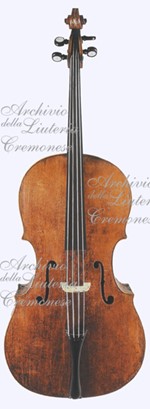1560/74 - Cello "The King"
Originally a bigger instrument, reduced in dimensions, that probably maintained the original outline of the CC. The belly is two-piece of medium-grained spruce. The back is five-pieces of maple, with a slightly irregular curl, with the remaining of the painted royal coat of arms of King Charles IX of France. On the ribs of maple, similar to the back, are some gild letters of the motto PIETATE ET IVSTICIA and two K surmounted by two crowns on the CC. The scroll is original, with signs of several restaurations of the peg box and remainings of the gilt decoration on the flanks and on the back.The varnish is orange-brown on a golden base.
- 12,12 cm
- 12,21 cm
- 11,54 cm
- Vermillion, South Dakota (USA) - National Music Museum
- 1560/74, Cremona
- Probably facsimile, dated 1572
- NMM 3351
- 23 cm
- 44,2 cm
- 34,2 cm
- 4,62 cm
- 6,95 cm
- 19,6 cm
- 75,6 cm
- John Betts 1812; Hollander; Sir William Curtis 1827; Rev. Alex H. Bridges (Beddington House, near Coryden, Surrey) 1872; John H. Bridges (Surrey) 1904; Rembert Wurlitzer Inc. 1967; Laurence C. Witten 1967; National Music Museum (University of South Dakota) 1984.
- 1872, Londra: Special Exhibition at South Kensington; 2007, Cremona: Andrea Amati. Opera Omnia, Les Violons du Roi
- Fetis 1851; Sandys-Forster 1864; Engel 1872; S.a. 1894; Heron-Allen 1895; S. a. 1904; Racster 1907; Grant 1910; Doring 1942; Putting & Simpson 1957; Sacconi 1972; Cowling 1975; Mosconi-Witten 1984; Downie Banks 1986; Larson 1988; Draley 1989; Bonetti 1989; Beare-Carlson-Mosconi 1991; Beare 1991; Hardgrave 2000; Sacconi 2000; Larson 2003; AA.VV. 2005; Dipper 2006; Cacciatori 2007
Immagini
| creato: | giovedì 8 marzo 2012 |
|---|---|
| modificato: | sabato 5 agosto 2017 |





